
Louis Lozowick (1892 - 1973)
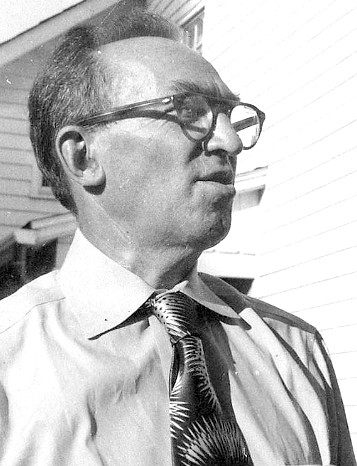
Louis Lozowick, Invaluable
"The artist's task is to sift and sort the material at
hand, mold it to his purpose by separating the
plastically essential trom the adventitious and,
in this manner, enrich the existing culture and
help to establish a new tradition." (Louis Lozowick, "The Americanization of Art", Machine-Age Exposition Catalogue, 1927, p. 18)
Louis Lozowick was a Ukrainian-born America artist and print maker. He is probably best known for his optimistic urban-themed monochrome prints. He was born in Ludvinovka, at the time a part of Russia, a town outside of present-day Kyiv, Ukraine. He enrolled in Kiev Art School, where he studied Russian Realism for two years. "His life changed, however, his brother was arrested shortly before the Revolution of 1905. Once out of prison, Lozowick's brother forged papers to move to New York and then sent for his younger brother, who, at fourteen, undertook an illegal border crossing, ultimately arriving at Ellis Island in 1906." (Sarah, McMillan, "Artist Profile: Louis Lozowick", Swann Auction Galleries website, gathered 9-2-24) Once in New York, he found a job in a factory and settled in New Jersey where he learned English. He began studying at the National Academy of Design from 1912 through 1915. In 1918, he graduated from Ohio State University, Columbus Phi Beta Kappa. During the next year, he traveled throughout America.
Between 1919 and 1924, Lozowick returned to Europe. He lived in Paris in 1920 where he got involved with the artistic community. He visited Moscow in 1922 then moved to Berlin where he remained until 1924. In Germany, he associated with avant-garde Russian artists affiliated with the socialist November-gruppe. The style of the individual artists in the group were known for a great deal of diversity, working in a variety of disciplines. This likely influenced Lozowick to adopt Modernist styles with a Cubist and Futurist bent. Solo exhibitions of Lozowick's art were put on in Berlin in 1992 and 1923. His paintings during his time in Germany were of his recollections of American cities he saw during his American journey. His first lithographs - Cleveland and Chicago - were created there. During his European stay, he became versed in artistic styles there such as Constructivism and de Stijl.
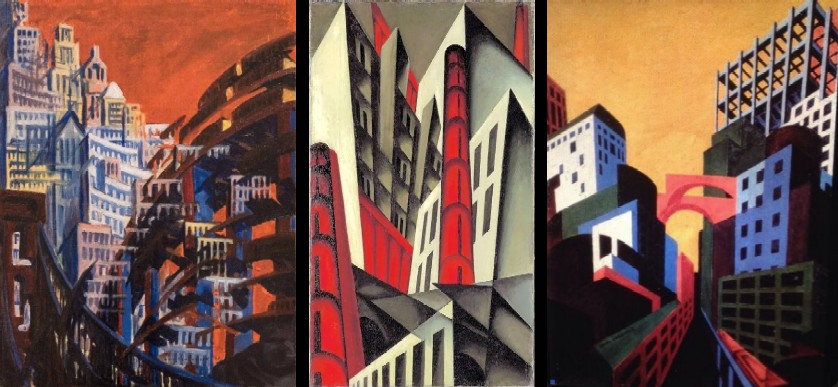 Louis Lozowick Paintings 1922-3, from left - New York (1922); Pittsburg, (1922); Chicago, (1923)
Louis Lozowick Paintings 1922-3, from left - New York (1922); Pittsburg, (1922); Chicago, (1923)
Louis returned to New York in 1924. He published the monograph 'Modern Russian Art' in 1925 and contributed drawings to the socialist periodical New Masses. By 1926,
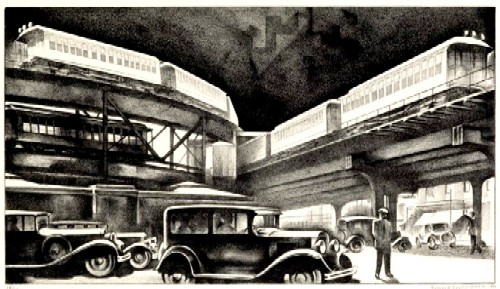
Louis Lozowick, Traffic, Lithograph (1930)
he had joined the editorial board of New Masses. He continued to explore lithography, helping to organize the 1927 Machine Age Exposition, which was advertised as the first to marry architecture, engineering, industrial arts and modern art. 1929 saw his first solo exhibition of lithographs at the Weyhe Gallery and Bookstore in New York, where his work focused on soaring urban and industrial scenes. He lectured on modern Russian art for the Société Anonyme and exhibited his machine drawings for them.
When the Great Depression hit the United States, much of Lozowick's focus shifted from the promise of industry and machinery to the plight of the laborers who maintained and built it. "Following a trip to the Soviet Union in 1932, he responded to the Depression in many subsequent works exemplifying the interests of social realism." ("Louis Lozowick (1892-1973)", Oxford Reference website, gathered 9-2-24) He got involved with US Government's public programs which supported artists including the New York Graphic Arts Division of the Works Progress Administration and the Treasury Relief Art Project. "Under federal sponsorship, Lozowick was able to create prints in various media and paintings, including a pair of murals for the New York City General Post Office in the late 1930s." ("Louis Lozowick Biography", Mary Ryan Gallery website, gathered 9-2-24)
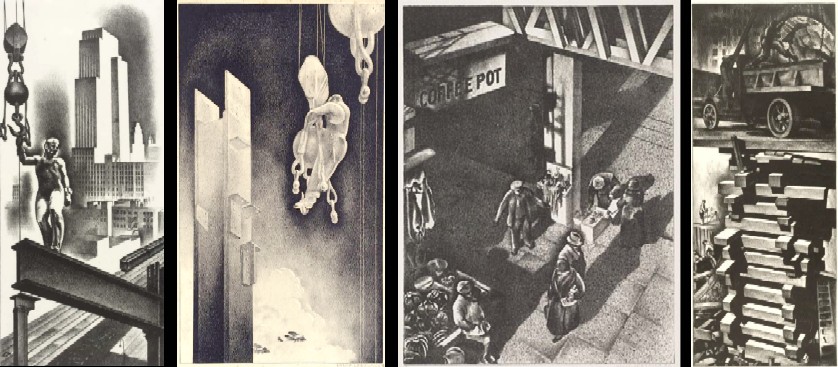 Louis Lozowick WPA Era Lithographs, from left - Above the City (1932), Mid-Air (1931), First Avenue Market (1934), Construction (1930)
Louis Lozowick WPA Era Lithographs, from left - Above the City (1932), Mid-Air (1931), First Avenue Market (1934), Construction (1930)
In 1943, he moved to South Orange New Jersey with his family. There he continued to teach and lecture and produce lithographs until his death. "Now his choice of subject became increasingly devoted to almost classic visions of figures posed in idyllic landscapes, picturesque trees and landmarks, or treasured vignettes from summer holidays and trips. ...A poetic sensibility that had been implicit in the soaring bridges and skyscrapers of earlier prints was now more frankly expressed
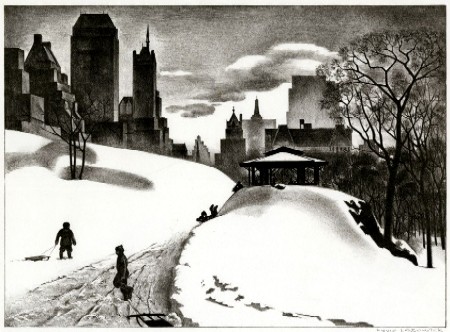
Louis Lozowick, Invaluable
in works that revealed an unembarrassed romanticism." (Janet A. Flint, The Prints of Louis Lozowick - A Catalogue Raisonné, 1982, New York, N.Y.: Hudson Hills Press. p. 29, cited by Wikipedia)
Nearly every discussion of Lozowick's style mentions Precisionism - a modernist art movement which appeared in the US after the first World War which was influenced by Cubism, Purism and Futurism. It is similar to the style of the November-gruppe Lozowick met in Germany. "Precisionist artists reduced subjects to their essential geometric shapes, eliminated detail, and often used planes of light to create a sense of crisp focus and suggest the sleekness and sheen of machine forms." (https://en.wikipedia.org/wiki/Precisionism) This description could easily be applied to many of the interior design pieces created during the Art Deco and Streamline Moderne period.
"Lozowick's work ranged over varied subjects, from machine abstractions to political protest to photographically realistic still lifes, but strong, restless forms generally dominate. During the 1920s he drew on travel impressions for a series of drawings, lithographs, and paintings inspired by the cities he visited. In these triumphant evocations of the urban and technological features of American life, he combined futurist and cubist techniques with a precisionist interest in geometric form, plain surfaces, hard edges, and depopulated spaces." ("Lozowick", Oxford Reference)
Sources Not Mentioned Above:
Calvin van Leeuwen, "Louis Lozowick: American, born Ukraine. 1892–1973" Museum of Modern Art, gathered 9-2-24
Esther Crain, "A midcentury printmaker celebrates machine age New York City", Ephemeral New York website, gathered 9-2-24
"November Group (German)", Wikipedia, gathered 9-2-24
"Precisionism", Wikipedia, gathered 9-2-24
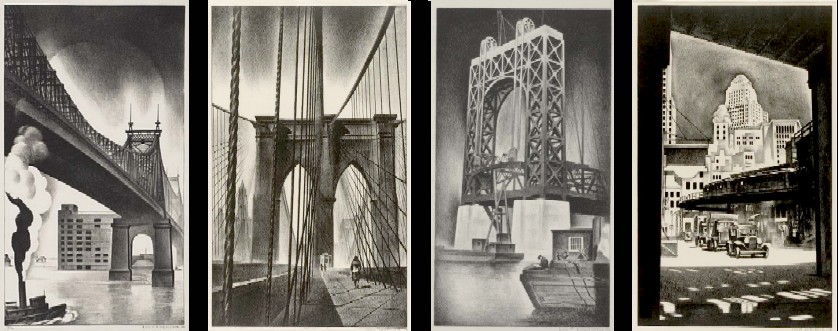 Lous Lozowick, New York Bridge Lithographs, from Left: Queensborough (1930); Brooklyn (1930); Hanover Square (1929); Triborough (1936)
Lous Lozowick, New York Bridge Lithographs, from Left: Queensborough (1930); Brooklyn (1930); Hanover Square (1929); Triborough (1936)